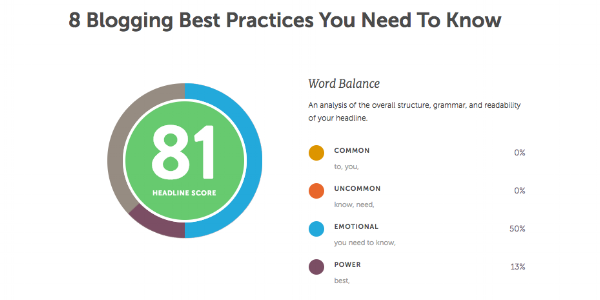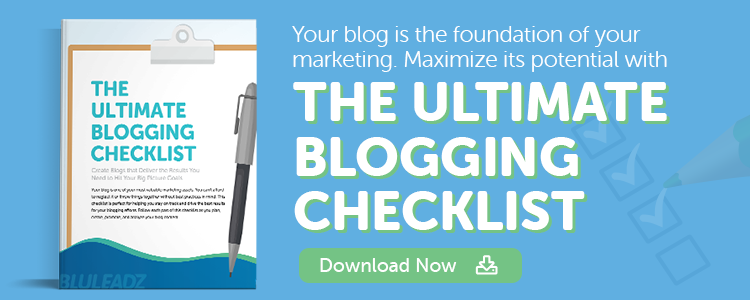10 Blogging Best Practices for 2020 to Help You Hit Your Traffic Goals
In the world of digital marketing, blogging goes beyond “putting pen to paper.”
When blogging for your business or your client’s business, it’s important to keep optimization at the forefront of your efforts.
But how exactly do you make your posts SEO friendly so that you can get your blogs in front of the people that matter?
What Makes a Business Blog Successful?
There isn’t a quick fix for blogging that makes all blogs successful. But there are blogs that get thousands of views and attract a bunch of readers. So what do they do to become successful?
Here are some key aspects that make a business blog a success:
They Are Informative.
Great blogs inform their readers about topics they are interested in. They teach and educate them to keep them engaged and gain repeat readership.
Readers who find your content interesting will share it and come back for more.
They Focus on Quality.
Quality is essential to a successful blog. A reader would rather consume 1,500 words of quality content, rather than 4,000 words of bad content.
To develop quality content, conduct research and fact check information.
They Have Clearly Defined Objectives.
Starting a blog should have a clear purpose, and you should set objectives for the outcomes you wish to have from your blog. Otherwise, you might be wasting resources in a misguided attempt to build your audience.
Successful blogs start with defined goals and know what they wish to accomplish.
They Publish on a Schedule.
A few blog posts isn’t enough to make a successful blog. Blogs require constant work, which means they need to be created and published regularly.
Consistency is key. Select your creation days, editing days, and publishing days and stick to them.
To learn how to make your blog successful, take a look at some of the best practices of blogging.
The Best Practices of Blogging
Here are 10 of the best practices for blogging to help you gain readers and web traffic.
1. Use Keywords.
To start off, brainstorm one long-tail keyword that you are trying to rank for that directly relates to your blog topic. You can use sites like Moz to help you choose your main keyword based on considerations like monthly search volume, difficulty, and organic click-through rate.
Make sure to include your main keyword in your blog title, URL, and meta description.
There is no magic number as to how many times this main keyword should appear throughout your post. You just want to ensure that you’re writing compelling content and working in that keyword where it naturally fits in – don’t feel the need to force it.
In addition to your main keyword, you can also sprinkle in some other keywords that are related to the topic at hand.
2. Use Click-Worthy Titles.

In order to drive traffic, shares, and search results, make sure your title is made up of common, uncommon, power, and emotion words.
CoSchedule’s Headline Analyzer is a great tool to help you get started – if your title ranks 70 or above, you’re doing great! However, the blogging best practice of including your main keyword in the title sometimes makes it hard to get your title to rank 70 or above.
Just remember, while you want to aim for 70+, it’s more important for you to include your main keyword and assign your blog a title that is accurate rather than misleading to your audience.
TLDR: Your title should be no more than 70 characters.
3. Pick a Niche and Stick with It.
A part of your blog’s purpose involves the topics you choose to write about. Business blogs can choose niches that are industry or specialty specific. This helps you to become and expert in your field and people will start seeing you as a thought leader. So pick a niche and be very, very good at it.
No matter what niche you choose, you need to make sure your blog readers know what to expect when they visit your blog.
If you run out of topic ideas for your niche along the way, check your competitors’ blogs that write about your niche and continuously research keywords and trending topics.
4. Write Accurate Meta Descriptions.

Google previously increased the character limit for the description snippet field to 300, only to then bring it back down to 160 characters about five months later.
While often overlooked, meta descriptions are quite important since they appear on Google search results pages and act as a description of what a specific page has to offer.
Metas should be an accurate, solution-based representation of what people can expect when they click through to your link. While a blogging best practice says to strategically include your keyword in your meta description, make sure to avoid keyword stuffing – it can actually hurt your SEO efforts.
TLDR: Meta character limit on a desktop = 160 characters; mobile = 130 characters.
5. Write Content For Your Audience.
The content you want to write and the content your audience wants to read aren’t always the same thing. Discover what your audience wants, what their problems are, and how you can help them through your content.
Write about the issues your audience really cares about. They don’t want to know about what you do, only what can help them. For instance, if you sell tires, don’t talk about manufacturing tires. Talk about how they can choose the right tire for their vehicle and which tires are the best for all terrain.
This is helpful and they might just consider buying your tires in the process.
6. Add Blog Tags.

Assigning blog tags, or categories, to your blog posts helps readers find the topic they’re looking for easily.
Think of tags as content themes throughout your website and blog topics. One tag should relate to a variety of keywords and topics that you have posted about, and you should assign no more than three tags to one post.
Make sure that the tags you choose are diverse and not just repetitive of one another as this can actually hurt your SEO efforts.
7. Link Internally and Externally.
When appropriate, including internal links and external links throughout your post is a great blogging best practice.
Along with reviving some of your old content and helping readers find what they’re looking for, internal linking allows you to highlight the validity of your own website.
You can link to other blog posts or to your webpages. Linking externally to reputable sources and authoritative bodies helps enhance the credibility of your content because you’re providing your readers with other helpful educational resources.
8. Post Often.
Posting on a schedule is important, but posting often is even more important. Posting at least one blog a week isn’t good enough. People want new content and they want it fast.
Not only do your readers want updates, Google also likes updates. This means that posting often and adding updates to old content is good for SEO. Updating your old content is a great way to refresh your blog when you have a library full of content that needs new data, more depth, and any other updates to make it more relevant.
9. Write Awesome Content.
It may seem contradictory to best practice #8, but your blog needs good content that is posted often. It is time consuming, but creating a great content strategy can help creating and publishing blog posts seem like second nature to you.
Awesome content needs to be:
- Well written
- Organized
- Entertaining
- Relevant
- Consistent
When you take the time to check all the boxes, your content actually helps to ensure that people come back to visit your blog. Sometimes you only get a few chances to prove that you have awesome content, so keep your quality high from the get-go.
10. Promote Your Blog and Encourage Engagement.
Promote your blog as often as you create content. To do this effectively, you should start by knowing where your audience hangs out on the internet.
Figure out which channels work best for your audience and promote your blog posts in those channels. And most importantly, be present and encourage engagement.
Pose questions, leave comments, and start conversations with your community. Ask your readers what they thought about your post. This helps to create a relationship between you and your audience, and they will begin to trust your authority over certain subjects.
With these blogging best practices in mind, you’ll be on the right track to building a better blog strategy and creating high-quality content for your readers.
BONUS. Perform an SEO Audit.
While your writing may be spot on, there are many other things that can effects your SEO.
That’s why it’s recommended to conduct a Technical SEO audit to see what you can do to improve your website’s performance.
If you don’t know how to do this yourself, we can perform a Technical SEO Audit for you, and give you a report in 2-3 days.
















![Toni Kroos là ai? [ sự thật về tiểu sử đầy đủ Toni Kroos ]](https://evbn.org/wp-content/uploads/New-Project-6635-1671934592.jpg)


